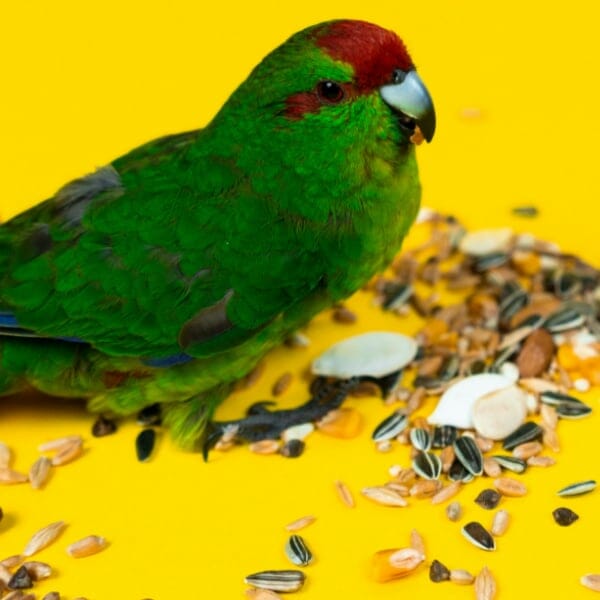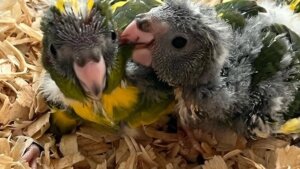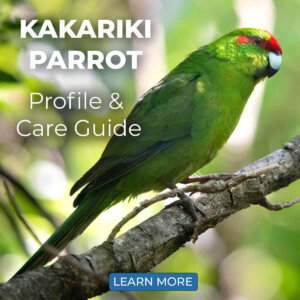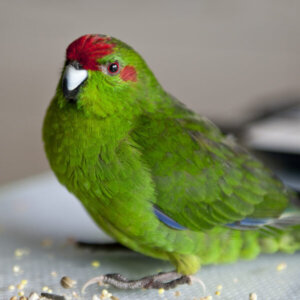What Do Kakarikis Eat: A Complete Nutritional Guide
Kakarikis are delightful and energetic parrots. They are known for their playful nature and vibrant colors.
But what do Kakarikis eat to stay healthy and happy? Feeding your Kakariki the right diet is crucial for its well-being. These little birds thrive on a balanced diet, which includes a mix of seeds, fruits, vegetables, and occasional proteins.
Understanding what to feed them can ensure they get the nutrients they need to live a long, vibrant life. In this blog, we will explore the dietary needs of Kakarikis, providing you with essential information to keep your feathered friend in top shape. From everyday staples to special treats, let’s dive into the world of Kakariki nutrition.

Credit: windycityparrot.com
Introduction To Kakarikis
Kakarikis are charming and vibrant parrots. Their cheerful nature and colorful feathers make them a popular choice among bird lovers. Understanding their diet is key to keeping them healthy and happy.
Who Are Kakarikis?
Kakarikis, also known as New Zealand parakeets, are small to medium-sized parrots. They are native to New Zealand and are known for their playful and curious nature.
There are three main species of Kakarikis: the Red-crowned, Yellow-crowned, and the critically endangered Orange-fronted parakeet. Each species has unique characteristics but shares similar dietary needs.
Importance Of Proper Nutrition
Proper nutrition is crucial for the well-being of Kakarikis. A balanced diet ensures they get the necessary vitamins and minerals. Healthy Kakarikis are more active and have vibrant plumage.
Here is a table summarizing the key components of a Kakariki’s diet:
| Food Type | Examples |
|---|---|
| Fruits | Apples, bananas, berries |
| Vegetables | Carrots, spinach, broccoli |
| Seeds | Sunflower seeds, millet, flax seeds |
| Pellets | Commercial parrot pellets |
Here are some important tips for feeding Kakarikis:
- Provide fresh water daily.
- Offer a variety of fruits and vegetables.
- Limit seeds to prevent obesity.
- Avoid chocolate, avocado, and caffeine.
By understanding their dietary needs, you can ensure your Kakariki thrives in your care.
Natural Diet In The Wild
Kakarikis, also known as New Zealand parakeets, have a varied diet in the wild. Their natural habitat provides a wide range of food sources that ensure they get all the nutrients they need to thrive. Understanding their natural diet helps in providing the best nutrition for pet Kakarikis.
Typical Food Sources
Kakarikis in the wild eat a diverse range of foods. Their primary diet includes:
- Seeds: Grass seeds, tree seeds, and shrub seeds form a major part of their diet.
- Fruits: They consume various wild fruits found in their natural habitat.
- Insects: They are known to eat insects, which provide essential proteins.
- Flowers: They nibble on flowers and buds, which add variety to their diet.
- Leaves: Fresh leaves and shoots are also part of their natural food.
Seasonal Variations
The diet of Kakarikis changes with the seasons. This ensures they get different nutrients throughout the year.
| Season | Food Source |
|---|---|
| Spring | Fresh leaves, buds, and early insects |
| Summer | Fruits, seeds, and a variety of insects |
| Autumn | Fruits, seeds, and mature leaves |
| Winter | Seeds and dried leaves |
During each season, Kakarikis adapt to the available food sources. This natural adaptation ensures they have a balanced diet throughout the year.
Essential Nutrients For Kakarikis
Kakarikis thrive on a diet rich in essential nutrients. Fresh fruits, vegetables, seeds, and pellets provide balanced nutrition. Regularly include leafy greens for vitamins and minerals.
Kakarikis are vibrant, active birds that need a balanced diet. Their diet must include essential nutrients to keep them healthy and energetic. Each nutrient plays a vital role in their well-being. Here, we will explore the crucial nutrients for Kakarikis.Proteins And Fats
Proteins are crucial for Kakarikis’ growth and repair. They help build strong muscles and feathers. Good protein sources include boiled eggs, legumes, and small amounts of cooked chicken. Fats provide energy and support cell structure. Seeds and nuts are excellent fat sources but offer them in moderation to prevent obesity.Vitamins And Minerals
Vitamins and minerals boost Kakarikis’ immune system and overall health. Vitamin A is essential for vision and skin health. Offer carrots, sweet potatoes, and dark leafy greens. Vitamin D aids in calcium absorption, crucial for bone health. Ensure they get enough sunlight or provide a vitamin D supplement. Minerals like calcium and iron are vital for bone strength and blood health. Include cuttlebone, leafy greens, and fortified pellets in their diet. “`Ideal Daily Diet
Kakarikis, also known as New Zealand parakeets, are active birds. They require a balanced diet to stay healthy and energetic. A proper diet ensures they get the nutrients they need. This includes a mix of seeds, fruits, and vegetables. Let’s dive into the ideal daily diet for Kakarikis.
Balanced Diet Components
A balanced diet for Kakarikis includes various components:
- Seeds: Seeds are a staple in their diet. Offer a mix of millet, sunflower seeds, and canary seeds. These provide essential fats and proteins.
- Fruits: Fresh fruits are vital. Include apples, pears, and berries. These provide vitamins and minerals.
- Vegetables: Vegetables are crucial. Serve leafy greens like spinach and kale. Carrots and peas are also good options.
- Pellets: Pellets ensure they get balanced nutrition. Choose high-quality pellets designed for parakeets.
- Fresh Water: Always provide clean, fresh water. Hydration is essential for their health.
Portion Sizes
Portion sizes are important to prevent overeating and obesity:
| Food Type | Daily Portion |
|---|---|
| Seeds | 2 tablespoons |
| Fruits | 1-2 small pieces |
| Vegetables | 1/4 cup |
| Pellets | 1 tablespoon |
| Fresh Water | Unlimited |
Adjust portions based on your bird’s activity level. An active Kakariki might need a bit more food. Always monitor their weight and health.
Fresh Fruits And Vegetables
Feeding your Kakariki a balanced diet is essential for their health. Fresh fruits and vegetables provide vital nutrients. These foods keep them active and happy. Let’s explore the best fruits and vegetables for your Kakariki.
Recommended Fruits
Kakarikis love a variety of fruits. Apples are a favorite. Remove the seeds before feeding them. Bananas are soft and easy to eat. Berries like strawberries and blueberries are also good choices. Offer small, bite-sized pieces. Grapes are sweet and hydrating. Mangoes add a tropical twist. Remember to remove the pits and seeds. Papayas and melons are also great options. These fruits are rich in vitamins and minerals.
Recommended Vegetables
Vegetables are equally important in a Kakariki’s diet. Carrots are crunchy and nutritious. Spinach is packed with iron. Broccoli is high in fiber and vitamins. Peas add variety and are easy to eat. Sweet potatoes are a favorite. They provide essential nutrients. Bell peppers are colorful and tasty. They offer antioxidants. Zucchini is light and hydrating. Ensure all vegetables are fresh and clean. Cut them into small, manageable pieces.

Credit: www.northernparrots.com
Seeds And Grains
Seeds and grains form an essential part of a Kakariki’s diet. These tiny treasures provide necessary nutrients and energy. They help keep these vibrant birds healthy and active. Understanding which seeds and grains are safe ensures your Kakariki’s well-being.
Safe Seeds
Many seeds are safe for Kakarikis. Sunflower seeds are a favorite, though they should be given in moderation. Safflower seeds are another excellent choice. They are low in fat and provide good nutrition. Millet seeds are also safe and beneficial. They are easy for Kakarikis to digest. Flax seeds offer omega-3 fatty acids, promoting healthy feathers. Ensure the seeds are clean and free from mold.
Types Of Grains
Kakarikis enjoy a variety of grains. Brown rice is a nutritious option. It provides fiber and essential vitamins. Oats are another good choice. They are rich in nutrients and easy to digest. Quinoa is a superfood for Kakarikis. It is packed with protein and amino acids. Barley is also safe and beneficial. It supports digestive health. Always cook the grains properly before offering them to your bird.
Supplementary Foods
Supplementary foods are a vital part of a Kakariki’s diet. They provide extra nutrients and keep these birds happy and healthy. Below are some important supplementary foods to consider for your Kakariki.
Treats And Snacks
Kakarikis love treats and snacks. These can be fruits, vegetables, or seeds. They enjoy a variety of flavors and textures.
- Fruits: Apples, pears, and berries are favorites.
- Vegetables: Carrots, peas, and corn are great choices.
- Seeds: Sunflower seeds and pumpkin seeds are excellent options.
Remember to offer these in moderation. Too many treats can lead to health problems.
Calcium And Mineral Blocks
Calcium and mineral blocks are essential for Kakarikis. They help keep their bones strong and healthy.
| Type | Benefits |
|---|---|
| Calcium Blocks | Support strong bones and beak health |
| Mineral Blocks | Provide essential minerals and support overall health |
Place these blocks in their cage. They will chew on them as needed. This simple addition can make a big difference in their health.
Foods To Avoid
Feeding your Kakariki a balanced diet is vital for their health. Yet, some foods can be harmful. Knowing what to avoid helps keep your bird safe.
Toxic Foods
Certain foods can be toxic to Kakarikis. Avocado is one such food. It contains persin, which is poisonous to birds. Chocolate is another harmful food. It contains theobromine, which birds cannot process. Even small amounts can be fatal.
Onions and garlic should also be avoided. They can cause digestive issues and blood problems. Caffeine is dangerous too. It can lead to heart problems and hyperactivity.
Unhealthy Treats
Some treats are not toxic but are still unhealthy. Avoid feeding your Kakariki sugary snacks. These can lead to obesity and other health problems. Salty foods are also a bad choice. They can cause dehydration and kidney issues.
Fatty foods should be limited. They can lead to weight gain and liver problems. Always check labels for hidden fats and sugars. Processed foods are a no-go. They often contain additives and preservatives that are harmful.
Feeding Tips And Best Practices
Feeding your Kakariki properly is crucial for their health and happiness. These small, energetic parrots need a balanced diet to thrive. Here, you’ll find essential tips and best practices for feeding your feathered friend.
Feeding Schedule
Maintaining a regular feeding schedule is important. It helps your Kakariki stay healthy and active. Offer fresh food twice a day, in the morning and evening. Remove any uneaten food after a few hours to prevent spoilage.
Here’s a simple feeding schedule:
| Time | Food |
|---|---|
| Morning | Fresh fruits, vegetables, and pellets |
| Evening | Seeds, grains, and fresh water |
Monitoring Health
Regularly check your Kakariki’s health. A balanced diet contributes to their well-being. Look for signs of good health, like bright eyes and clean feathers.
Monitor their weight and activity level. If you notice any changes, consult a vet. Keep an eye on their droppings, too. Healthy droppings are firm and consistent in color.
Here are some health tips:
- Fresh Water: Change it daily.
- Variety: Provide a mix of fruits, veggies, and pellets.
- Supplements: Offer calcium and vitamin supplements if needed.
By following these tips and best practices, you can ensure your Kakariki stays healthy and happy.

Credit: feistyfeathers.com
Frequently Asked Questions
What Are The Best Foods For Kakarikis?
Kakarikis thrive on a varied diet. Offer them fresh fruits, vegetables, seeds, and pellets. Include leafy greens, carrots, apples, and berries.
Can Kakarikis Eat Human Food?
Yes, but with caution. Some human foods are safe, like cooked grains and vegetables. Avoid toxic foods like chocolate and avocado.
How Often Should I Feed My Kakariki?
Feed your Kakariki twice a day. Offer fresh food in the morning and evening. Provide constant access to fresh water.
Do Kakarikis Need A Special Diet?
Yes, a balanced diet is crucial. Ensure they get a mix of fruits, vegetables, seeds, and pellets for optimal health.
Conclusion
Kakarikis thrive on a varied diet. Fresh fruits, vegetables, and seeds are essential. Offer them leafy greens like spinach and kale. Apples, berries, and bananas are great fruit options. Provide seeds and pellets for balanced nutrition. Avoid chocolate, caffeine, and avocado as they are toxic.
Clean water should always be available. With proper care, Kakarikis live healthy and happy lives. Feeding them well strengthens your bond and ensures their well-being. Enjoy caring for your colorful, lively companion!
Hello Dear, I'm Poli Kolymnia, owner of many birds (including budgies).
With a deep passion for these feathered companions, I'm here to share my expertise and extensive knowledge on birds care.
My articles cover essential topics like diet, housing, care, and health, providing practical tips to help you create a happy and thriving environment for your birds.







